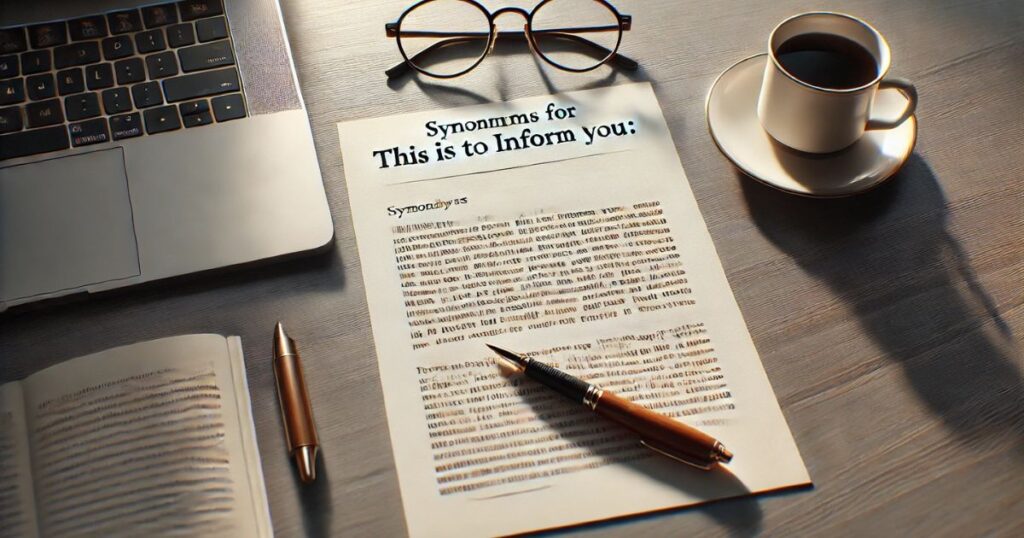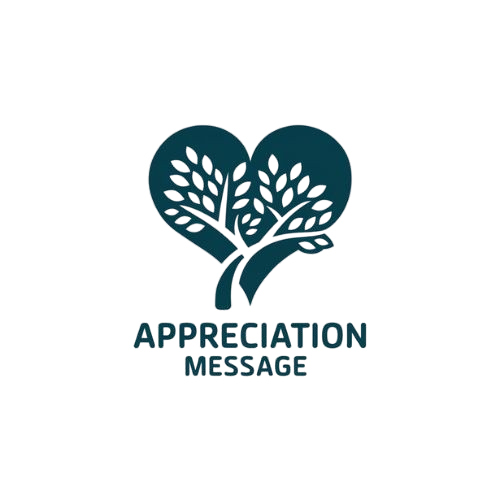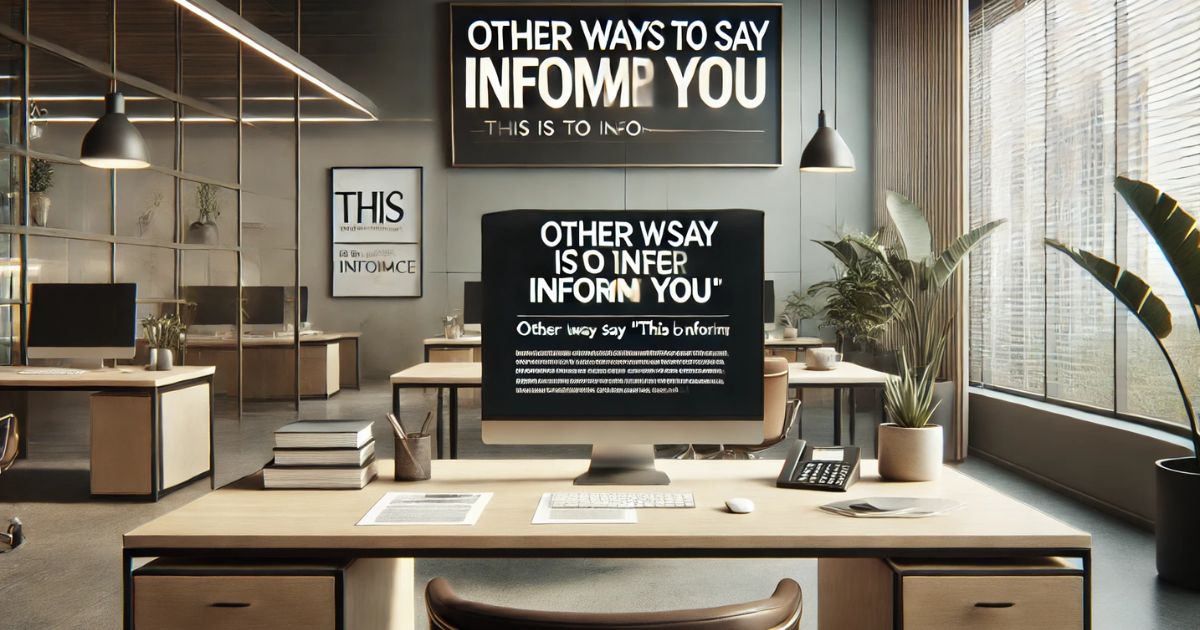Want to make your emails sound more polished and engaging? Repeating “This Is to Inform You” in every message can feel robotic and dull. But don’t worry there are plenty of better ways to say it! Choosing the right words can make your writing clearer, more professional, and even more engaging. Whether you’re sending an important email or drafting a formal letter, the right phrasing makes a big difference.
Looking for Other Ways to Say “This Is to Inform You”? Try “Just to inform you” for a softer touch. Need a direct tone? Use “I want to inform you that” instead. Writing a formal notice? A “This is to inform you that letter sample” can be your guide. Small changes in wording can enhance clarity and professionalism. Mastering these alternatives will improve your workplace communication and leave a lasting impression!
What Does “This Is to Inform You” Mean?
This is to inform you is a formal phrase used in emails and letters. It signals important information, updates, or announcements. People use it in workplaces, business communication, and official notices. It ensures clarity and professionalism while delivering messages. However, using different phrases can make writing sound more natural and engaging.
Instead of repeating it is to inform you that, try softer or more direct alternatives. Just to inform you works well for a polite tone. I want to inform you that makes it more personal. If writing a formal letter, use this is to inform you that letter sample as a reference. Choosing the right phrase improves readability.
Is It Professional/Polite to Say “This Is to Inform You”?

Saying “This Is to Inform You” is professional, but it can sound too formal or stiff. In business emails, a softer tone often works better. Phrases like “I want to inform you that” or “Just to inform you” make communication clearer and more natural while keeping professionalism in workplace messages.
Using “This Is to Inform You” in official notices or legal documents is appropriate. However, in regular office communication, consider alternatives. A polite phrase like “I’d like to inform you” sounds more engaging. Choosing the right wording helps maintain a balance between professionalism and friendliness in business writing.
Advantages and Disadvantages of Using “This Is to Inform You”
Using “This Is to Inform You” makes messages clear and direct. It works well for formal emails and official letters. However, it can sound repetitive or too rigid in certain situations. Choosing alternative phrases helps maintain professionalism while keeping communication engaging and natural.
Advantages:
- Ensures clarity in official communication
- Maintains a professional tone in emails
Disadvantages:
- Can sound repetitive in frequent use
- Lacks a conversational or friendly tone
Read Also: 35 Other Ways to Say “Please Note” (With Examples)
Synonyms for This Is to Inform You:

Formal communication requires clear and professional language. Instead of using “This Is to Inform You” repeatedly, try different phrases to keep your writing fresh. Whether you’re sending an email, a letter, or a workplace update, using synonyms ensures clarity while maintaining professionalism. Below are alternative ways to phrase it.
- I Wanted to Let You Know
- I Am Writing to Inform You
- Just to Inform You
- I Would Like to Notify You
- I Want to Inform You That
- Please Be Advised That
- Kindly Note That
- This Is to Bring to Your Attention
- I Wish to Inform You
- I Am Reaching Out to Inform You
- You Should Be Aware That
- I Would Like to Bring to Your Attention
- I Am Writing to Notify You
- This Is to Let You Know
- For Your Information
- I Want to Bring to Your Notice
- Allow Me to Inform You
- I Am Pleased to Inform You
- I Would Like to Make You Aware
- Be Informed That
- I Need to Notify You About
- I Would Like to Let You Know
- I Am Writing to Bring This to Your Attention
- I Wish to Bring to Your Notice
- I Am Writing to Make You Aware
- I Want to Update You That
- Here’s Something You Should Know
- Please Note That
- I Must Inform You That
- This Is a Formal Notification
1. I Wanted to Let You Know
Meaning: A polite and approachable way to share information.
Definition: This phrase signals that you are providing an update in a warm yet professional manner.
Scenario Example: “I wanted to let you know that your request has been approved.”
Best Use: Suitable for emails or messages where a friendly tone is preferred.
Tone: Warm and conversational.
2. Please Be Aware
Meaning: A formal way to bring attention to important details.
Definition: This phrase is used to ensure the recipient takes note of the provided information.
Scenario Example: “Please be aware that the office will be closed on Monday.”
Best Use: Ideal for business emails, policies, and official announcements.
Tone: Professional and direct.
3. Just to Update You
Meaning: A simple and clear way to provide new information.
Definition: This phrase conveys that you are sharing an update or progress on a matter.
Scenario Example: “Just to update you, we have completed the first phase of the project.”
Best Use: Perfect for emails or reports that require status updates.
Tone: Informative and neutral.
4. For Your Information (FYI)
Meaning: A quick and effective way to share details without requiring a response.
Definition: This phrase indicates that you are providing information for awareness only.
Scenario Example: “FYI, the new policy changes take effect next week.”
Best Use: Used in internal communication, emails, and memos.
Tone: Brief and neutral.
5. I Thought You Should Know
Meaning: A casual yet considerate way to share relevant details.
Definition: This phrase suggests that the information might be useful or important to the recipient.
Scenario Example: “I thought you should know that the client requested an extension.”
Best Use: Best for friendly emails or team updates.
Tone: Personal and engaging.
6. I’d Like to Inform You
Meaning: A formal way to introduce important information.
Definition: This phrase conveys an official or necessary notification.
Scenario Example: “I’d like to inform you that your payment has been processed.”
Best Use: Used in business emails and formal letters.
Tone: Professional and polite.
7. Just So You Know
Meaning: A relaxed and informal way to share information.
Definition: This phrase is often used in friendly communication to pass along details.
Scenario Example: “Just so you know, we’re meeting at 3 PM instead of 2 PM.”
Best Use: Best for internal team updates or casual conversations.
Tone: Friendly and informal.
8. I Would Like to Bring to Your Attention

Meaning: A professional way to highlight key information.
Definition: This phrase ensures the recipient understands the significance of the details.
Scenario Example: “I would like to bring to your attention the changes in the HR policy.”
Best Use: Best for corporate emails, memos, and formal letters.
Tone: Serious and professional.
9. Kindly Note
Meaning: A polite yet firm way to deliver information.
Definition: This phrase requests the recipient’s acknowledgment of the information.
Scenario Example: “Kindly note that the deadline has been extended.”
Best Use: Ideal for official announcements and workplace communication.
Tone: Respectful and formal.
10. I’m Writing to Inform You
Meaning: A direct and formal way to introduce information.
Definition: This phrase is used when sending official communication.
Scenario Example: “I’m writing to inform you that your application has been accepted.”
Best Use: Common in business emails and professional letters.
Tone: Formal and clear.
11. I’d Like to Make You Aware
Meaning: A polite phrase used to highlight an important update.
Definition: This phrase is used when ensuring someone understands new information.
Scenario Example: “I’d like to make you aware of the upcoming changes in the schedule.”
Best Use: Suitable for professional communication.
Tone: Formal and neutral.
12. I Would Like to Let You Know
Meaning: A formal yet approachable way to communicate important details.
Definition: This phrase ensures that the recipient acknowledges the given information.
Scenario Example: “I would like to let you know that the project deadline has shifted.”
Best Use: Used in professional emails and reports.
Tone: Respectful and professional.
13. This Is to Notify You
Meaning: A formal way to provide an official update.
Definition: This phrase is commonly used in corporate and legal communication.
Scenario Example: “This is to notify you that your contract has been renewed.”
Best Use: Best for official letters and business communication.
Tone: Serious and professional.
14. I Am Bringing This to Your Attention

Meaning: A structured way to highlight something important.
Definition: This phrase ensures the recipient focuses on a particular matter.
Scenario Example: “I am bringing this to your attention as it may impact your work.”
Best Use: Ideal for workplace emails and internal communication.
Tone: Professional and neutral.
15. I Wanted to Make You Aware
Meaning: A polite way to introduce important details.
Definition: This phrase ensures the recipient understands relevant information.
Scenario Example: “I wanted to make you aware that there will be a system update tonight.”
Best Use: Ideal for business updates and formal communication.
Tone: Professional and considerate.
16. Just a Heads Up
Meaning: A casual way to provide a quick update.
Definition: This phrase is used when giving informal yet useful information.
Scenario Example: “Just a heads up, the report deadline has been moved to Friday.”
Best Use: Best for friendly workplace conversations.
Tone: Informal and friendly.
17. I Wish to Inform You
Meaning: A formal way to introduce news or updates.
Definition: This phrase is often used in official letters and emails.
Scenario Example: “I wish to inform you that your application has been processed.”
Best Use: Suitable for professional communication.
Tone: Formal and respectful.
18. I Am Writing to Notify You
Meaning: A professional way to deliver official news.
Definition: This phrase is used when sharing formal announcements.
Scenario Example: “I am writing to notify you that your appointment has been confirmed.”
Best Use: Best for business letters and formal emails.
Tone: Serious and professional.
19. Please Take Note
Meaning: A polite but firm way to emphasize important details.
Definition: This phrase signals that the recipient should remember the information.
Scenario Example: “Please take note that the office will be closed next Friday.”
Best Use: Ideal for work-related updates and policies.
Tone: Formal and direct.
20. I Just Wanted to Inform You
Meaning: A softer way to provide necessary details.
Definition: This phrase makes an announcement sound more conversational.
Scenario Example: “I just wanted to inform you that we have changed our meeting time.”
Best Use: Suitable for emails or workplace communication.
Tone: Friendly and approachable.
21. I Am Here to Inform You
Meaning: A direct way to present information.
Definition: This phrase ensures that the recipient understands a clear message.
Scenario Example: “I am here to inform you that the project has been approved.”
Best Use: Used in professional conversations and announcements.
Tone: Formal and straightforward.
22. Allow Me to Inform You
Meaning: A respectful way to share information.
Definition: This phrase signals that the speaker has something important to communicate.
Scenario Example: “Allow me to inform you that your request has been granted.”
Best Use: Ideal for business emails and polite communication.
Tone: Formal and courteous.
23. I’m Letting You Know
Meaning: A simple and friendly way to update someone.
Definition: This phrase is used in casual but important messages.
Scenario Example: “I’m letting you know that your package has been shipped.”
Best Use: Best for workplace updates or customer service emails.
Tone: Friendly and professional.
24. Just to Keep You Informed
Meaning: A polite way to maintain communication.
Definition: This phrase is used when providing updates on ongoing matters.
Scenario Example: “Just to keep you informed, we are reviewing your request.”
Best Use: Best for progress updates and ongoing conversations.
Tone: Polite and neutral.
25. I Would Like to Notify You
Meaning: A formal way to introduce official information.
Definition: This phrase is used in business and legal communication.
Scenario Example: “I would like to notify you that your payment is overdue.”
Best Use: Ideal for official letters, policies, and legal notices.
Tone: Direct and professional.
26. For Your Consideration
Meaning: A polite way to share relevant details.
Definition: This phrase suggests that the recipient should review the information.
Scenario Example: “For your consideration, we have included additional options.”
Best Use: Best for proposals and professional discussions.
Tone: Formal and respectful.
27. I Just Wanted to Let You Know
Meaning: A warm and conversational way to inform someone.
Definition: This phrase makes messages sound approachable and polite.
Scenario Example: “I just wanted to let you know that the report is ready.”
Best Use: Suitable for workplace communication.
Tone: Friendly and natural.
28. I Am Honored to Inform You
Meaning: A respectful way to deliver good news.
Definition: This phrase expresses a sense of pride or joy in sharing information.
Scenario Example: “I am honored to inform you that you have been selected for the award.”
Best Use: Best for formal announcements.
Tone: Respectful and celebratory.
29. It Is My Pleasure to Inform You
Meaning: A warm way to deliver positive updates.
Definition: This phrase conveys happiness in sharing good news.
Scenario Example: “It is my pleasure to inform you that you got the job.”
Best Use: Ideal for professional and formal settings.
Tone: Joyful and formal.
30. I Would Like to Advise You
Meaning: A polite way to give recommendations or updates.
Definition: This phrase is often used when offering professional guidance.
Scenario Example: “I would like to advise you that the policy has changed.”
Best Use: Suitable for business and advisory emails.
Tone: Professional and informative.
31. I Am Writing to Let You Know
Meaning: A straightforward way to share important details.
Definition: This phrase is used when providing updates in a professional setting.
Scenario Example: “I am writing to let you know that your request has been approved.”
Best Use: Ideal for formal emails and letters.
Tone: Professional and neutral.
32. I Am Reaching Out to Inform You
Meaning: A polite way to begin a message with important information.
Definition: This phrase is used when addressing someone in a business or customer service setting.
Scenario Example: “I am reaching out to inform you that our services have been updated.”
Best Use: Best for professional and corporate emails.
Tone: Courteous and professional.
33. Kindly Be Advised
Meaning: A formal way to provide official information.
Definition: This phrase emphasizes that the recipient should take note of the details.
Scenario Example: “Kindly be advised that the policy has been updated.”
Best Use: Suitable for business, legal, and formal communication.
Tone: Polite and formal.
34. Please Note That
Meaning: A direct way to highlight key information.
Definition: This phrase is used when giving instructions or updates.
Scenario Example: “Please note that the deadline has been extended.”
Best Use: Best for workplace announcements and emails.
Tone: Direct and informative.
35. I Am Sending This Message to Inform You
Meaning: A structured way to introduce news or updates.
Definition: This phrase ensures the recipient understands the purpose of the message.
Scenario Example: “I am sending this message to inform you of a schedule change.”
Best Use: Suitable for professional and academic emails.
Tone: Formal and precise.
36. It Is Important to Inform You
Meaning: A way to emphasize the significance of the information.
Definition: This phrase is used when conveying urgent or critical details.
Scenario Example: “It is important to inform you that your contract has been renewed.”
Best Use: Best for formal messages that require immediate attention.
Tone: Serious and professional.
37. I Want to Keep You Updated
Meaning: A friendly way to provide ongoing information.
Definition: This phrase helps maintain open communication.
Scenario Example: “I want to keep you updated about our upcoming event.”
Best Use: Suitable for work-related and personal updates.
Tone: Friendly and engaging.
38. I’d Like to Bring This to Your Attention
Meaning: A polite way to highlight important details.
Definition: This phrase ensures the recipient notices specific information.
Scenario Example: “I’d like to bring this to your attention before the meeting.”
Best Use: Best for business discussions and official emails.
Tone: Formal and professional.
39. I Am Providing This Information for Your Awareness
Meaning: A professional way to ensure the recipient is informed.
Definition: This phrase emphasizes that the details are shared for reference.
Scenario Example: “I am providing this information for your awareness regarding the new policy.”
Best Use: Suitable for workplace and corporate updates.
Tone: Formal and informative.
40. I Wanted to Share Some Important Information
Meaning: A warm and engaging way to introduce news.
Definition: This phrase is used when sharing relevant details in a conversational tone.
Scenario Example: “I wanted to share some important information about the new company policies.”
Best Use: Ideal for business emails and general communication.
Tone: Friendly and professional.
FAQ’s
What are Other Ways to Say This Is to Inform You?
You can say just to inform you, i want to inform you that, or use this is to inform you that letter sample for formal emails.
Why should I use Other Ways to Say This Is to Inform You?
Using different phrases keeps messages professional and engaging. It avoids repetition and makes workplace communication more effective.
When should I use Other Ways to Say This Is to Inform You?
Use them in emails, business letters, and official notices. They improve clarity and professionalism in workplace communication.
Can I use Other Ways to Say This Is to Inform You in casual emails?
Yes, but use a friendly tone. Instead of this is to inform you, try just to inform you for a softer approach.
How do Other Ways to Say This Is to Inform You improve writing?
They help make messages clear, professional, and engaging. Using alternatives keeps your writing fresh and avoids sounding repetitive.
Conclusion
Choosing Other Ways to Say “This Is to Inform You” makes your writing better. It helps you sound clear and professional. Instead of using this is to inform you in every message, try different phrases. For a softer tone, say just to inform you. If you need to be direct, use i want to inform you that. When writing official letters, a this is to inform you that letter sample can guide you. These small changes make a big impact.
Using Other Ways to Say “This Is to Inform You” improves communication. It keeps emails and letters fresh and engaging. Instead of repeating this is to inform, try new phrases. Your message stays professional while sounding natural. Whether you write to a client, employee, or colleague, better wording matters. Learning different expressions will boost your email writing skills. Other Ways to Say “This Is to Inform You” make workplace communication smooth and effective.

